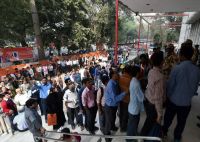
The country is witnessing an unparallel public support and sacrifice to fight black money after Prime Minister launched demonetization. At the same time, trends show liquidity paralysis is catching the economy that may affect even the country’s GDP growth.
On the other side, bank staffs are working hard to meet both demonetization process and liquidity injection.
Finance Minister indicated that the process of enabling new note delivery through the ATMs or recalibration will start in two weeks. He said that preparing the ATM for handling the newly designed thin notes of Rs 2000 and Rs 500 denominations has not done early as it may led to leak of the demonetization decision.
Calibration enables the ATM to understand the technical and size features of currency notes so that they can provide notes through the machine. Since the present information given to computers inside the ATM are that of old notes, a recalibration is needed to supply the newly designed notes.
At present ATMs are giving only Rs 100 notes that are used only for small transactions like travel and restaurant needs. Reports from different part of the country shows acute shortages of currency notes that is slowly percolating into a monetary paralysis. Existing direct supply of notes through banks and post offices have a bias towards Rs 2000 denominations with Rs 500 notes very short in supply.
Responsibility of the government is huge as it is in the process of refilling nearly Rs 1418000 crore worth of currency notes that accounts for 86% of total money supply.
According to the RBI Annual Report, total currency note supply in the country as on March 2016 was Rs 1418000 core and out of these, Rs 500 and Rs 1000 constituted to 86.4%. The largest circulating currency unit is Rs 500 that has a share of 47.8% in the total share in notes circulation in terms of value.
Under the new monetization plan, a portion of them is injected in the form of Rs 2000 notes.
RBI is urging public to use digital transactions. But India being a currency using country, experts points out the difficulty of sudden shifting to digital transactions for the mass. Small businesses and ordinary economic engagements are settled in currencies. Similarly, bulk of the population is yet to use digital payments in a regular basis. On the other hand, medium and large scale businesses can remain shielded to an extent.
Last day the RBI has indicated that its presses are in full-fledged operation to print new currencies. “To sustain the demand, printing presses are printing the currency notes at full capacity so that adequate quantum of notes is available,” RBI statement said.
Besides recalibration delay, some unavoidable factors like purposefully delayed printing of most demanded currency units of Rs 500 has also added to the problem. If the printing of Rs 500 had done in advance, it would have led to a leak of the critical demonetization decision.
Bulk of the ATMs are not working and the working selected ones are also overworked to deliver the precocious Rs 100 notes.
Overall, the decision well taken to counter the menace of restricting black money is slowly creating liquidity squeeze in the economy by hurting the most currency using sections of the population – the common man and the lowest income strata. Those who uses digital transactions on a regular basis are insulated.
*********











